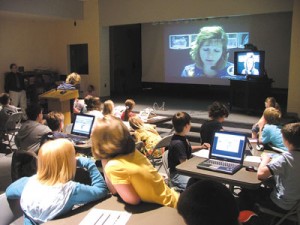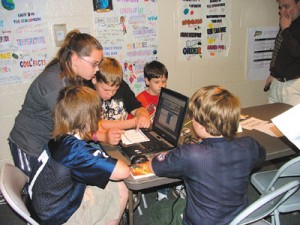 |
 |
Fourth grade students at Tyrone Area Elementary School took part in an innovative, distance learning program that simulated real-life situations in order to enhance science, math and technology skills.
These students linked with Wheeling Jesuit University’s Center for Educational Technologies (CET) in Wheeling, W.Va., to participate in “e-Mission: Moon, Mars, and Beyond.” The first e-Mission launched on Tuesday, May 20 with Mrs. McMillan’s, Mrs. Getz’s, and half of Mrs. Judy’s fourth graders. Then, a duplicate e-Mission launched on Wednesday, May 21 with Mrs. Fries’, Mrs. Toto’s, and the other half of Mrs. Judy’s fourth graders.
According to Kathleen Frank, assistant flight director, “The CET program is an innovative, hands-on learning experience that enhances classroom exercises to foster interest in math, science and technology in elementary, middle, and high school classrooms.”
“For those schools who could not travel to Wheeling to participate in an on-site simulated mission, the Center developed the distance learning program that connects a flight director at the CET with students anywhere in the world for a one-of-a-kind learning experience,” added Frank.
Each participant was assigned to a planet team to work as scientists in order to solve problems in real-life situations. The mission challenged participants to apply their mathematics and science knowledge to a real-life event. During the 90 minute simulation, these students helped NASA and worked with the Flight Director at Mission Control to locate a lost spaceship called the Distant Discovery that has been orbiting the outer planets.
Additionally, the teams calculated the amount of food, water, and oxygen that would be required for a round trip rescue of the Distant Discovery.
“By placing participants into the roles of astronauts and scientists trying to solve a real-life problem, they are hooked,” Bruce Howard, program developer at CET says. “This fascination with space science exploration permeates the hearts and minds of the young and young at heart across every ability level or learning style. The model is based on the latest developments in cognitive science research and has proved to increase students’ achievements and attitudes towards science, math and technology.”
For teachers, the e-Mission is a new way to introduce planet science into classroom instruction. Prior to the scheduled e-Mission, teachers received pre-flight curriculum they could incorporate into their daily lesson plans. The teachers used these lessons, as well as those they modified or created themselves.
“These lessons addressed Pennsylvania Academic Standards in the areas of language arts, math, science, and technology,” stated Cheryl McMillan, fourth grade teacher. “In preparation for this mission, the children conducted research and read books about the planets, then wrote reports or created posters to display their research.”
Students also used their measurement skills to create a scaled down model of the solar system.
“This model showed the relative distance of the planets from the sun, as well as their relative size,” added Shelly Toto, fourth grade teacher.
Students used different size round objects to represent the planets. (For example, Pluto was a marble, Mars and Mercury were each ping-pong balls, Neptune and Uranus were beach balls, and Jupiter was a hula hoop.) Knowing the order of the planets was necessary to successfully rescue the lost ship during the actual e-mission.
In addition to measuring, students also practiced plotting coordinates by playing Over and Up Squares, which is a game that is part of their new Everyday Math series. The Navigation Specialists used this skill during the mission to graph the coordinates, identify the unknowns, and determine the path of the lost ship.
All planet groups, retrieved data sent to them by Earth Mission Control via the computer. They used this data, in addition to handouts that were given to them by the Communication Officers from Mission Control, to cooperatively solve problems. They had to draw conclusions to help rescue the lost ship. Communications Officers reported their findings to Earth Mission Control.
“Being on the communications team was more fun than I expected. How many kids get to talk to an astronaut? It’s a memory I’ll keep forever!” explained Sarah Isenberg, student Communications Officer.
Careful math calculations were necessary to draw accurate conclusions during the e-mission.
“The Cargo Teams worked very well together to recommend the right amount of food, water, and oxygen needed for the rescue trip. You had a lot of math to do, and all the information was perfect. Your math teachers should be very proud of you!” said Commander Pleva, Flight Director for the Challenger Learning Center.
According to student surveys following the e-missions, their favorite part was being able to communicate live with the Flight Director.
“I liked being able to see and talk to the Mission Control Commander,” said Mary Beth Raabe, student Transmission Specialist.
When asked in the survey if she would change anything about the mission, Finnley Christine, student Cargo Specialist reported, “I would change nothing. It was awesome!”
All students agreed that the mission was an exciting learning experience.
“The children were involved in higher-level thinking activities, as well as cooperative learning. Incorporating content from many different subjects, while addressing different learning styles, made this such a worthwhile experience for the children as well as the teachers,” replied Jeanine Fries, fourth grade teacher.
“This experience was rich with 21st century skills, which will help children succeed in the ever-changing global society, such as collaboration, problem solving, higher order thinking, interactive communication, and technology literacy,” added David Fernandes, Tyrone Area School District Technology Coach.